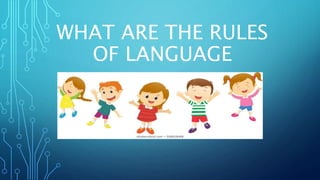
Rules of Language Presentation
- 1. WHAT ARE THE RULES OF LANGUAGE
- 2. PRESENTATION DONE BY: •SAMEENAH PARKER:217259324 •TAIMIYAH JEAN:218044593 •HASEENAH AHMED:218101996 •HOPE-ESTHER JOCHEMS:218006276
- 3. PHONOLOGICAL RULE •Phonological rules are for combining the individual sounds of the language into words. •The sounds of a language are known as phonemes, which may be consonants or vowels. •In English, phonological rules do not allow the sound combination d+n at the beginning of a word.
- 4. • Phonological awareness is an important skill that enables children to learn the phonological rules of a language. • This auditory skill may be difficult for children learning a second language if there are sounds in the second language that do not occur in their first language. • They will need to be taught to hear and say such sounds, before learning to read the second language.
- 5. MORPHOLOGICAL RULE • Morphological rules are used to organize words. • A morpheme is the smallest unit of meaning in a language. • “Cat” is a morpheme because c, a and t are meaningless on their own. We can add “s” onto the end of “cat” to change the meaning to more than one cat. • We can also add the morpheme “ed” onto the end of “kick” to change the meaning from present into past tense.
- 6. • Morphological rules are important in helping children work out the meaning of new words. • Example: if they want to know the word “happy” – they may be able to understand words like “unhappy” or “happily” • Second language learners can be taught how to do this by developing their morphological knowledge of the language.
- 7. SYNTAX • Syntax refers to the rules that specify word order. This means how sentences are organized, the relationship between words, word classes and other elements of a sentence. • Sentences are organised according to their function, i.e. whether they are statements, commands or questions. • The main parts of a sentence are noun and verb phrases, each made up of various word classes.(nouns, verbs, adjectives, adverbs)
- 8. • Different languages have different syntactic rules and children learning a second language will need to learn the syntax of the language as well as the phonology and morphology.
- 9. SEMANTICS • Semantics is the component of language that dictates the meaning of words. • Our knowledge of words forms our mental dictionary or lexicon, also known as vocabulary. • Children learn a large number of words in their first few years of life, but we continue to expand our vocabulary throughout our life as we are always exposed to new information.
- 10. •Children learning a second language need to learn a new vocabulary. •However, if they already have a concept in their first language they merely need to learn the word for it in their second language. • A second language may be acquired more rapidly than the first language.
- 11. PRAGMATICS • Pragmatics is the use of language as a communication tool to achieve various purposes. • Pragmatics is about communicative intentions, the rules of conversation and the way in which different types of discourse are constructed. • Pragmatics is very dependent on culture. Different cultures communicate in different ways. • Learning a second language means that you need to learn about different ways of communicating.
- 12. THE END THANK YOU FOR WATHCHING
